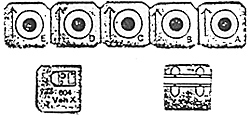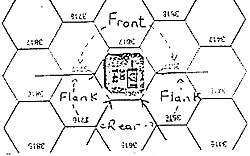 Fans of TSRs FIREFIGHT game may wish to try these rules in their next gaming session.
Fans of TSRs FIREFIGHT game may wish to try these rules in their next gaming session.
1. Mines (18.0).
Allow hex sides to be mined in the same manner as hexes. Put an arrow tick mark on the mine counter to designate which hex side is mined. Units attempting to cross a mined hex side remains in its current hex while the mine attack is resolved. if no effect the unit can cross. Artillery delivered mine fields (25.0) may not be designated for a hex side.
Placing of mines along a hex side comes in handy for defending bridges and towns retaining your freedom for your own units defending in the hex itself.
2. Bridging Units.
Use the vehicle X counters (numbers 601 to 605) to represent the bridging units present in both the US and USSR forces. These vehicles, often built on the chassis of a tank, can quickly lay a bridge over an otherwise impassible river, opening up new avenues of attack. Players designing their own scenarios may wish to include their use.
Bridge layers are treated as a tank target with a Kf or Kms combat result destroying its ability to lay the bridge. After three turns remaining stationary a bridge counter is placed across the adjacent river hex side at the beginning of the movement phase. Once placed the bridge may not be destroyed. Each bridge layer may lay one bridge.
Used in conjunction with the impassible river rules bridge layers can add excitement to play of your next scenario.
3. Tank Evasive Maneuvering
When under attack tanks and APCs could maneuver with radical course changes in attempt to through off the aim of the attacker.
To reflect this in the game subtract 1 from the movement allowance of each vehicle designated as using Evasive Maneuvering. The tank receives a -2 column shift to any - direct fire and opportunity fire at tacks against it. Each side declares which APC and tanks are conducting evasive movement at the start of the movement phase and its effects last until the beginning on the next movement phase of the following turn. With the larger scenarios markers might be needed as a helpful reminder to the players of which units are so designated.
Vehicles using Evasive Maneuvering may not use road or trail movement (7.1) nor may they overrun (28.0) or conduct short halt attack/fire an move (17.0). Mounted combat (16.0) is also prohibited for Evasively Maneuvering vehicles.
Players may initially think that vehicles will start using this rule routinely for all movement but after a few games it will be used only sparingly. The restrictions sometimes outweigh the benefits!
 4. Target Facing and Flank Shots
4. Target Facing and Flank Shots
Despite modern advances in design the tank and APC is still vulnerable to a flank shot. To reflect this in the game, add target facing rules and flank shot attacks as follows:
- a. All vehicles in the game must face towards a
specific hex side at all times. Each vehicle must enter the hex
side it faces and in each new hex entered the
vehicle may re-orient itself to any hex side. A vehicle
which does not enter a new hex may change its hex side
facing (pivot) at the cost of 1 mp. A vehicle may
move to the hex directly behind it (moving in
reverse) at double the normal movement costs.
b. A direct fire attack against a vehicle whose LOS enters the target hex through a flank or rear hex side as shown in the above diagram receives a +2 column shift. If the target vehicle is directly behind a defilide hex side no column shift is obtained.
5. Artillery Target Lists (8.1)
The current rules allows a player to list 4 planned targets per artillery unit (8.13). This creates super flexible artillery. A much more plausible number would be one less, allowing three planned targets per artillery unit. In addition, one of the three planned targets must be within three hexes of one of your own units as a final protective fire (FPF) target. This hex may be the same as a friendly unit.
6. Unit Initiative
NATO forces are currently counting on the better quality of their individual units to offset the larger Warsaw Pact forces. To add this factor into the game try the following:
- a. Instead of trading individual unit
activations in the Direct Fire and Movement Phases
each player takes turns rolling a die on the below
table to determine the number of units he can
activate in a row before the other player rolls an the
the table. The number obtained is the number of
direct fire attacks he can conduct in a row or,
during the movement phase, the number of units he may
move before the opposing player gets a chance to
move. Opportunity fire rules remain unchanged.
| Die Roll | US | USSR |
|---|---|---|
| 1 | 3 | 2 |
| 2 | 2 | 2 |
| 3 | 2 | 1 |
| 4 | 2 | 1 |
| 5 | 1 | 1 |
| 6 | 1 | 0 |
Back to Strategist Number 202 Table of Contents
Back to Strategist List of Issues
Back to MagWeb Master Magazine List
© Copyright 1989 by SGS
This article appears in MagWeb (Magazine Web) on the Internet World Wide Web. Other military history articles and gaming articles are available at http://www.magweb.com